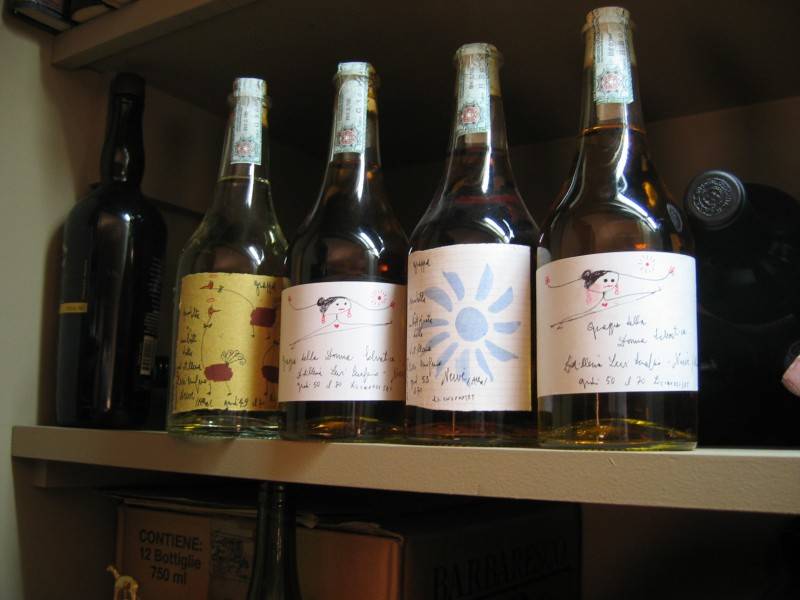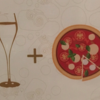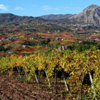Grappa -- The Perfect Way to End a Meal
A glass of grappa has always been my favorite way to end a good meal. Grappa, made from the skins and pulp of grapes that have been pressed into wine, originated as a peasant drink, but has become fashionable and expensive especially when marketed in elegant blown glass bottles.
In November friends said that they were going to visit Bruno Giacosa, a wine producer in the town of Nieve in Piemonte. My first reaction was “Giacosa is across the street from Serafino Levi!” In Europe, Levi‘s grappa is legendary and almost impossible to get.
The first time Michele and I went to visit Levi was in 1983. There were no signs or people to ask, and finally, we spotted a man riding a bicycle. Instantly I knew that it was Romano Levi. He reluctantly invited us to visit his distilleria which consisted of only one still and one old barrel for aging the grappa, located in his backyard. The labels are hand drawn by his sister and the most famous is the aged Grappa della Donna Selvatica.
As we watched, a delivery of vinaccia of nebbiolo grapes arrived from Angelo Gaja. We expected to taste the grappa, but Romano produced a tiny bottle suspended from a string and dipped it into the barrel. He poured a few drops into our hands and showed us how by rubbing them together and warming them we were able to release the aromas. He made a gesture as if to put it behind his ears as perfume. It was like no other grappa we had tried before, but when we indicated that we wanted to buy some, he was only willing to part with one bottle. But we spoke only in English and finally he let us have two, probably just so that we would go away! As we were leaving, he said in Italian “Remember, only one grappa after dinner!” Each bottle cost 10,000 lira (about $8).
We did not return to Nieve until three years ago when Michele was writing an article for The Wine Spectator and we brought with us an empty bottle of the grappa we had bought in 1983. We visited Giacosa and asked when Levi was open but he did not know. We returned three times before learning that the distilleria is only open Wednesday and Saturday afternoons.
Romano Levi was ill at the time and we did not see him. However his sister refilled the bottle for us and sold us two more. One bottle per person is the limit, but they will refill as many empty bottles of their grappa as you can carry. (Do not try to come back a week later and try to buy another bottle; they will not sell it to you.) They were 20 euros apiece ($25). The grappa is available in the nearby town of Alba for 60 euros ($75) if they will sell it to you. When we returned to pick up our refill, we saw two men leaving. They were shouting in German and patting each other on the back as they held high their bottles of Levi grappa in victory. In Alba all the stores had displays of books, many in German, praising Levi and his grappa.
When I told my friends about the Levi grappa, they decided to go to see what all the fuss was about and I gave them an empty bottle to refill. I am happy to report that they were successful and met with Romano Levi, who was very pleased to see the bottle they had brought all the way from the States. The grappa is now 30 Euros a bottle.
In Italy, grappa is drunk as a digestivo, a drink that helps digestion after a meal. Grappa is made from vinaccia, what we call pomace, the skins, and the pulp of the fruit left over after the grapes have been pressed to make wine. The pomace is distilled in a double-boiler distillation system known as the bagno maria. Some producers age grappa in small wood barrels (barriques) for many years to give it a smoother taste along the lines of cognac. I like my grappa to be clear except for the Levi which is aged in an old barrel for very short period. The one thing that one can say about grappa is that if it is good grappa, it tastes uniquely like grappa and that is something you will have to find out by tasting it yourself.
At home, many Italians make flavored grappa by infusing bottled brands with fruits or herbs such as rue, cinnamon, chamomile, oranges, lemons, cherries, figs, etc. Once, a Piemontese wine producer gave us his secret recipe for infusing grappa. It can work with an orange or lemon. Take a jar with a tight seal, fill it about two-thirds full with grappa, and then add sugar. Suspend an orange over the grappa (they should not touch!) in a piece of cheesecloth and close the jar. Put in a cool dry place for three months. The orange will drip juices and oils into the grappa and you will have orange grappa. Another way to make it is to put the fruit directly into the grappa and sugar mixture. Dried figs work best. We tried it with blueberries, but the grappa did not change color and Michele complained that the blueberries tasted like grappa pills. Don’t use your finest grappa if you want to try it.
A number of good grappas are available here. Since it is illegal in Italy to make wine and grappa in the same production facility, producers have to send their vinaccia to a distiller. In my opinion you are better off buying a grappa bottled under the distiller’s label rather than a wine producer’s because you know what you are getting. Nonino, Poli, Marolo, Bocchino, Berta and Nardini are all distillers and make a wide range of different grappa’s as well as other distillates made from fruits, chestnuts, honey, etc.
Grappas I especially like include Giacomo Poli’s Sarpa. At $52 it is one of his least expensive, though one of this producer’s best. Nonino’s Fragolino is a great grappa though it sells for $140. Nardini, the largest selling brand in Italy, has a grappa with a sprig of Ruta, or rue, in it, said to help you digest. A liter is priced at $48. For a double digestivo effect, try Nonino’s Amaro, $38 which has a base of grappa.
Marolo’s grappa infused with chamomile is perfect in a cup of tea when you have a cold. It costs $88. For a smooth aged grappa, Berta makes Tre Soli Tre made from nebbiolo di barolo. It was distilled in 1995 and bottled in 2006 and costs $188. Ue (Friulian dialect for grape) looks like grappa but is different because it is made from the whole unpressed grapes. It is not aged and will have the words “immature brandy” on the label.
Romano Levi’s production of his wonderful grappa is very limited and, sadly, it is not available here, nor are two other of my favorites. Look for them when you are in Italy. Nonino’s Vuisinar is aged up to three years in small casks made of wild cherry (Vuisinar). One of the most unusual and interesting grappas I ever tasted is made from the pomace of the grapes used to make vin santo from Tenuta Capezzana (Tuscany). Fruity and nutty, it has a very pleasant aftertaste but still tastes like grappa. The vin santo from Capezzana is so rare that you know their vinaccia was used!
In Rome a few years ago, we had dinner in one of our favorite restaurants, Checchino dal 1887. The owner came around with the grappa cart, and said “help yourself” and left it by our table. In the interest of research, I, of course, tasted all of them. Going back to the hotel, Michele laughed because I had to walk with my hand touching the walls of the buildings, the only way I could remain upright. Block after block, Michele kept on whispering the same thing in my ear "As Romano said, ‘only one grappa after dinner’.” I have heeded those words since.





































i-Italy
Facebook
Google+
This work may not be reproduced, in whole or in part, without prior written permission.
Questo lavoro non può essere riprodotto, in tutto o in parte, senza permesso scritto.